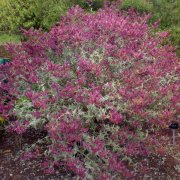Care of the shrub Salvia canariensis or Canary Island sage |
|
The genus Salvia, family Lamiaceae, comprises 1,000 species of shrubs and herbaceous plants native to Asia, Africa, the Mediterranean region, and Central and South America. Some species are: Salvia canariensis, Salvia aurea, Salvia apiana, Salvia africana, Salvia scabra, Salvia lanceolata, Salvia farinacea, Salvia leucantha, Salvia guaranitica, Salvia namaensis, Salvia greggii, Salvia microphylla, Salvia mexicana, Salvia splendens, Salvia disermas, Salvia vaseyi, Salvia leucophylla, Salvia verbenacea, Salvia sclarea, Salvia mellifera, Salvia nemorosa, Salvia officinalis, Salvia fruticosa, Salvia elegans, Salvia x sylvestris. Common name: Canary Island sage. This species is native to the Canary Islands. They are shrubs covered with whitish hair that reach 2 meters (6.56 feet) in height. The leaves, light green and hairy, have a lanceolate-triangular shape. The spectacular and long-lasting bloom of numerous lilac or violet flowers attracts butterflies and bees. They bloom from spring to early fall. Canary Island sage is used to form screens, in bushy groups in dry areas of the garden and as isolated specimens. Salvia canariensis prefers full sun exposure but can also grow in light shade. It's able to withstand some frosts down to about -5 ºC (23 ºF). Canary Island sage can grow in any type of soil as long as it's well drained; it does not resist excess water. Salvia canariensis is a quite resistant to drought plant; water moderately waiting for the substrate to dry. Fertilize with compost in late winter. Canary Island sage can be lightly pruned after flowering to give them a more compact appearance. Salvia canariensis is a resistant plant to the usual pests and diseases. Canary Island sage is propagated from seeds sown in spring or fall. |
Images of the shrub Salvia canariensis or Canary Island sage |
Find plants
Salvia canariensis or Canary Island sage | Care and Growing
© 2026 FavThemes


